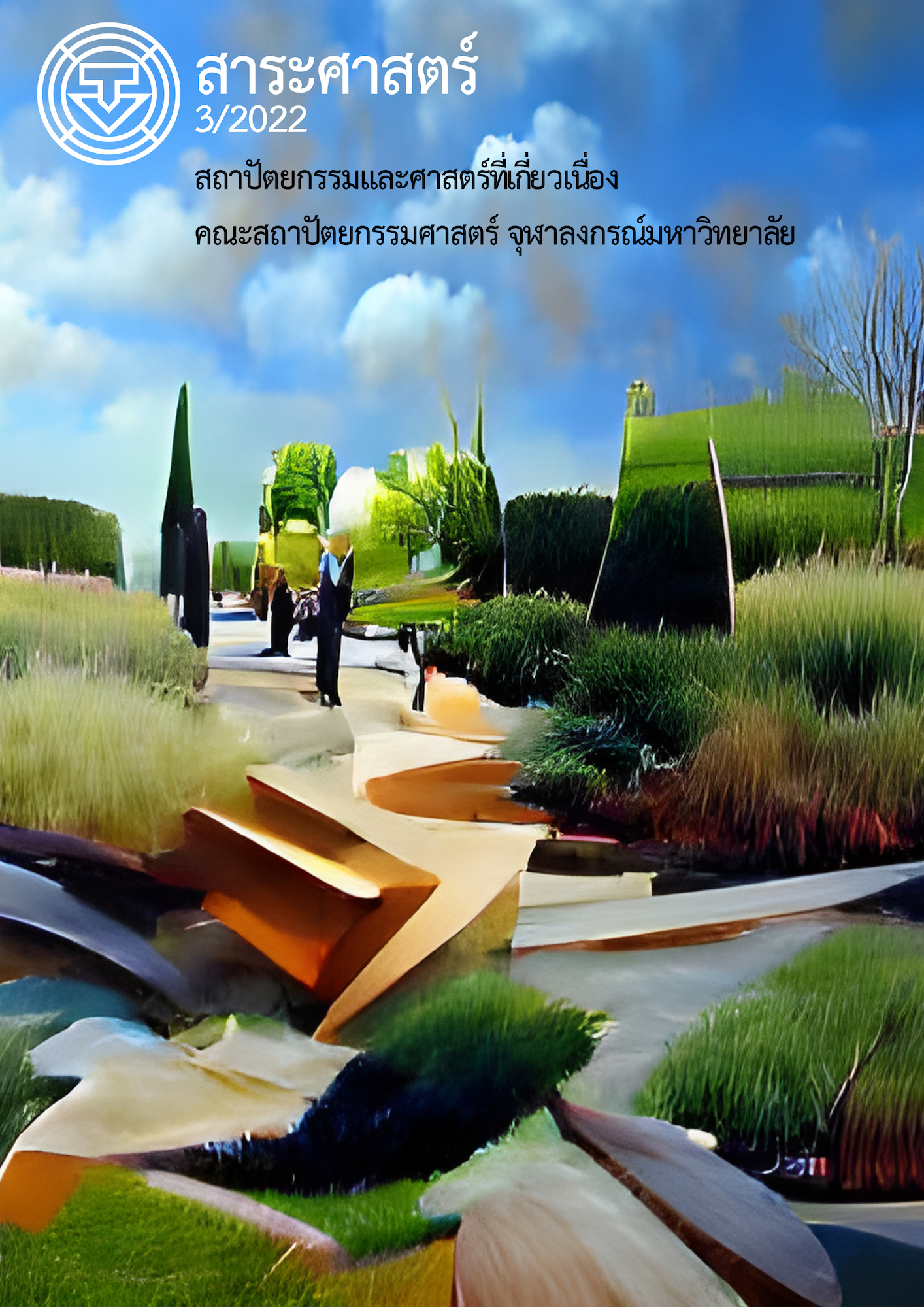The Development of Corporate Landscapes in Thailand
Main Article Content
Abstract
Corporate landscape refers to a type of landscape architecture used as a corporate workplace. In the mid-twentieth century, due to high urban density, several leading corporations in the United States relocated their offices to the suburbs. The planning and design of these new workplaces were exceptional and included not only the workplaces, but also residences and other amenities. Louise A. Mozingo called this new landscape “Pastoral Capitalism” and regarded it as “an American invention of the post-World war II period.” The American corporate landscape got attention from a number of corporations all over the world. The concept of an innovation district recently gained popularity - as the business related to innovation and technology has advanced dramatically. The goals of this research included 1) to gather the corporate landscape projects in Thailand, and 2) to analyze their development patterns, in terms of temporal and spatial dimensions. The research located 46 corporate landscapes in Thailand; the first one was established in 1933. Considering their chronological development, the pioneering corporate landscapes in Thailand are those of service industry and state enterprise, followed by real estate industry, construction industry, and finance sector, respectively. After the 1977 economic crisis, Thailand's economy rebounded with the service industry and tourism industry. Until recently, the corporate landscapes of innovation and technology industry increases. The country's economic policy and fluctuation, along with the digital revolution seem to play a role in this trend. Regarding the locations of these corporate landscape projects, they are mostly concentrated in Bangkok and its vicinity, and the provinces in the lower Central region as well as along the coastline of the Eastern region. The urban planning regulations, the economic policy, and the concentration of the business network in Bangkok seem to play a role in this spatial pattern. This research significantly provides information and insight for the governmental agencies to develop the policies, and for the corporations to develop the idea regarding their workplace environment, in order to advocate the establishment of new and novel corporate landscapes in Thailand. Future research on recommendations for planning and design of corporate landscapes in Thailand is tremendously crucial for landscape professionals, as well as those in related fields.
Article Details
References
จารุพรรณ วานิชธนันกูล, วรพจน์ หงส์ภิญโญ และ สุโชติ เปี่ยมชล. (2554). การลงทุนภาคเอกชนในระยะต่อไป : เดินเครื่องต่อหรือรอเครื่องดับ. กรุงเทพฯ: สายนโยบายการเงิน ธนาคารแห่งประเทศไทย.
รชต สนิท. (2564). จับตาธุรกิจเอเชีย จัดอันดับบริษัทที่น่ายกย่องที่สุดในโลก ปี 2021 โดย Fortune. สืบค้นจากhttps://brandinside.asia/asian-companies-in-top-50-by-fortune/
รวิพรรณ สาลีผล. (2555). ประวัติของเศรษฐกิจไทยตั้งแต่ 2475. กรุงเทพฯ: สำนักวิชาเศรษฐศาสตร์และนโยบายสาธารณะ มหาวิทยาลัยศรีนครินทรวิโรฒ.
รุจิโรจน์ อนามบุตร และ วิลาสินี สุขสว่าง. (2550). การศึกษาทัศนคติต่อภูมิทัศน์ของโรงไฟฟ้าวังน้อย จังหวัดพระนครศรีอยุธยา: รายงานฉบับสมบูรณ์. กรุงเทพฯ: การไฟฟ้าฝ่ายผลิตแห่งประเทศไทย.
ลงทุนแมน. (2565). กรณีศึกษา “ยุโรป” ทวีปที่เน้นขาย “เรื่องราว และ ยา.” สืบค้นจาก https://www.longtunman.com/36793
ลงทุนศาสตร์. (2564). สงครามโลกครั้งที่ 2 ส่งผลต่อเศรษฐกิจโลกขนาดไหน. สืบค้นจาก https://www.investerest.co/economy/ the-economic-impact-of-world-war-ii/
วันชัย บุนนาค. (2559). บทเรียนสถาบันการเงิน:กรณีศึกษาคดีปล่อยสินเชื่อของธนาคารกรุงไทย จำกัด (มหาชน). สืบค้นจาก https://prachatai.com/journal/2016/03/64540
สุพริศร์ สุวรรณิก. (2563). ย้อนรอยนโยบายเศรษฐกิจไทยในอดีต. สืบค้นจาก https://www.bot.or.th/Thai/ResearchAnd Publications/articles/Pages/Article_09Nov2020.aspx
สถาบันการมองอนาคตนวัตกรรม และ งานนวัตกรรมเชิงพื้นที่ ฝ่ายโครงสร้างพื้นฐานนวัตกรรม. (2562). ย่านนวัตกรรม กรุงเทพมหานคร. กรุงเทพฯ: สำนักงานนวัตกรรมแห่งชาติ.
Bruegmann, R. (2013). Pastoral capitalism: A history of suburban corporate landscapes by Louise A. Mozingo review by: Robert Bruegmann. Journal of the Society of Architectural Historians, 72(1), 110-112.
Castells, M., & Hall, P. (1994). Technopoles of the world: The making of twenty-first century industrial complexes. Oxfordshire: Routledge.
Chandrasekar, K. (2011). Workplace environment and its impact on organisational performance in public sector organisation. International Journal of Enterprise Computing and Business Systems 1(1).
Kaplan, R. (1993). The role of nature in the context of workplace. Landscape and Urban Planning, 26(1), 193-201.
Katz, B., & Wagner, J. (2014). The rise of innovation districts: A new geography of innovation in America. Washington, DC: Brookings.
Milligan, B. (2010). A corporate landscape urbanism. Retrieved from https://freeassociationdesign.wordpress.com/2010/07/07/corporate-landscape-urbanism/
Mozingo, L. A. (2011). Pastoral capitalism: A history of suburban corporate landscapes. Cambridge, MA: MIT Press.
@NetworkBCN. [n.d.]. El Districte 22@ Innovation District. Retrieved from https://www.22network.net/districte-22/?lang=en


